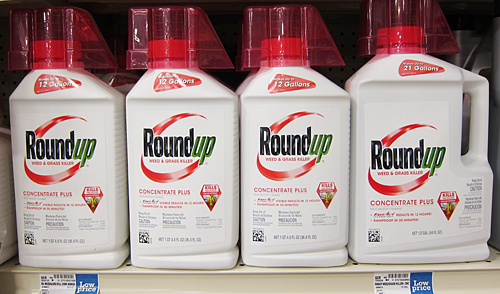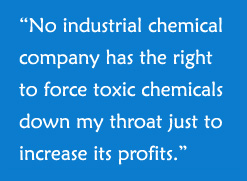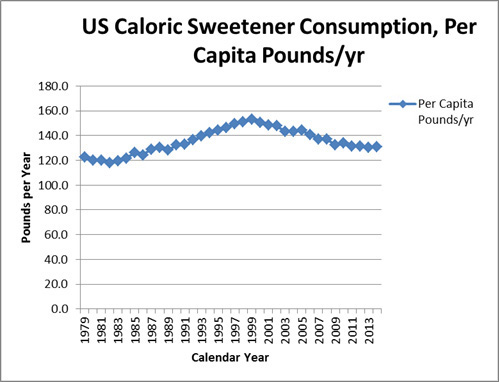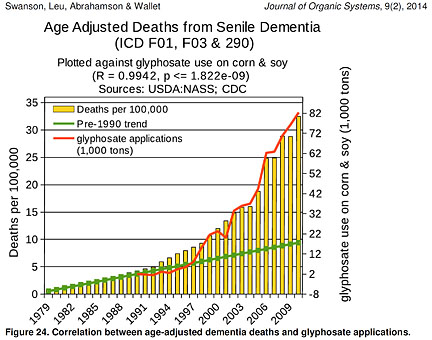







This is an archived article. Click here to return to the blog's home page.
Eat Organic, or Die
Mounting evidence suggests glyphosate in food supply linked to serious diseases
Entry 14: January 18, 2016.

Roundupģ: Not just for weeds anymore; itís in our breakfast, lunch, and dinner.
Iíve always trusted our foods to be safe to eat. In the
summer of 2015, that changed. After
some meals I felt miserable, with intense pain in the small intestine. I feared I might be
experiencing a return of the cancer Iíd been treated for in 2011. That turned out
to be wrong, thankfully. After
further research and experimentation with my diet, Iíve concluded the pain is
from emerging contaminants in the food supply that the US Food and Drug
Administration (FDA) should be monitoring and regulating. The contaminants
are glyphosate and surfactant additives, used in Monsantoís herbicide Roundupģ
and similar products from other manufacturers. I have personally noticed
symptoms that indicate contamination in whole-wheat and soy products and after
talking to some farmers, found a possible route for that contamination.
Roundupís maker, Monsanto, is popularizing its use as a preharvest accelerator
for ripening wheat, soy, and other crops. You can read about this use
at the following link:
Preharvest Staging Guide
http://roundup.ca/_uploads/documents/MON-Preharvest%20Staging%20Guide.pdf
This is a Canadian document. Why isn't it at a US website
address? Well, this way it's outside the purview of US regulators even
though any farmer can find it online. For wheat, the optimal application of the chemical is three to five days prior
to harvest. That's not sufficient time for it to degrade into harmless
substances. The herbicide allows harvest to proceed at a predictable time,
useful if bad weather is expected. It
also evens out the ripeness of a crop, so areas of unripe grain in a field catch
up in just a few days. But the
contamination problem could be much larger than whatís used for grain  ripening. Over 90% of the corn and
soy in the US are now genetically modified (GM) to be tolerant of Roundup.[1]
These crops are called ďRoundup readyĒ because the product can be
directly sprayed on them with no damage.
ripening. Over 90% of the corn and
soy in the US are now genetically modified (GM) to be tolerant of Roundup.[1]
These crops are called ďRoundup readyĒ because the product can be
directly sprayed on them with no damage.
ďEat Organic, or DieĒ is a provocative title. Skeptical readers may be aware of a recent study that claimed organic food had no measurable health benefits.[2] However, the study had a number of qualifiers that donít allow a firm conclusion to be drawn regarding Roundup contamination in conventionally-grown foods. Because Roundup is widespread in the food supply and its levels in foods vary depending on seasonal and regional weed populations and the preferences of individual farmers, the only way to know if there is an effect from consuming it would be to do a carefully controlled experiment where all foods eaten were tested and the subjects would need to be monitored for many years to detect harmful changes. Such studies have been done with only very limited populations and durations, and for general organic diets, not ones specifically controlled for Roundup exposure.
Hereís my personal experience. In June and July 2015, I had three episodes of small bowel obstruction that spontaneously resolved. After two of those, I ate fresh whole-wheat pasta prepared at a local restaurant. The third episode was after eating some dried soy nuts. At the time these incidents happened I sought medical treatment, but the doctors were baffled because a CT scan and ultrasound came back normal. Before the episodes I had abdominal surgery for colorectal cancer, and the original thought was that I might have abdominal scar tissue. I didn't suspect food contamination at the time. Scar tissue usually worsens gradually, and I expected to have more episodes with eventual admission to the hospital for surgery. However, for the reasons below that did not happen and the episodes didn't recur. The tests were expensive, and itís quite worrying to believe that I might end up needing emergency surgery at any moment.
Because two episodes happened after eating the pasta I discussed the suspicion of food contamination with my partner, who is a farmer. He told me that Roundup is sprayed on wheat, and I should look into it. I found Monsantoís preharvest guide from a web search. I also researched the symptoms of glyphosate ingestion and one of them is ileus, a temporary paralysis of the small bowel. That's exactly what I had. Since that time, I have switched to organic whole-wheat products and soybeans as a precaution and have had no further symptoms. Since Roundup is applied to the surface of the wheat it would likely be at higher levels in whole-wheat products where the bran is part of the flour. For white flour products, the milling process would remove the bran, and likely most of the glyphosate and surfactant as well.
I am not gluten intolerant. I eat a lot of wheat, and one of the incidents was after eating soybeans that were labeled gluten-free, but not organic. Due to my cancer, I changed my diet to include a lot of fiber and whole wheat as it is one of the dietary interventions known to reduce colon cancer risk. It seemed odd that eating all this ďhealthfulĒ fiber would cause so many problems. Now that Iím eating organic wheat and soy, my digestion has improved to be the best it's been since my cancer surgery. That also sounds suspicious as I had a lot of minor stomach upset before that's now gone away. Perhaps other people on gluten-free diets are really avoiding Roundup sensitivity but don't know it, and if they eat non-organic soy may be confused as to why they still have symptoms of intolerance without gluten in their diets. If youíre one of those, switching to organic whole wheat and soy may eliminate symptomsóand mean gluten intolerance isnít the problem.
At a recent checkup, I shared this information with one of my oncologists. He suggested I contact the Oregon Health Division and report it. I did that on December 13, 2015. They havenít responded. Our government is overlooking a potentially major problem of widespread food contamination and needs to start testing for residues of Roundup and surfactants in grains. The FDA has been dragging its feet because testing for Roundupís original Environmental Protection Agency (EPA) registration concluded the product wasnít toxic in humans. Toxicity testing is simple and sometimes harmful effects donít show up until after widespread use. There have been documented cases of ileus in people who ingested the product as a result of intentional poisoning.[3] Both chemicals need to be tested in food to understand if they are related to public health problems.
Herbicide registration with the EPA focuses on the potential for:
| Harm to humans, wildlife, fish, and plants, including endangered species and non-target organisms. | |
| Contamination of surface water or ground water from leaching, runoff, and spray drift.[4] |
Toxicity studies used for EPA registration emphasize whatís called LD50, the lethal dose that kills 50 percent of the population. Rats are typical test subjects. The drawback to reliance on this measure is that the animals are usually observed for three months or less. Some chemicals donít kill shortly after ingestion but they cause temporary discomfort or gradual long-term damage. Thatís still harm, especially if it results in medical expenses, lost productivity, interruptions to a personís life or job, and the need to follow a special diet to avoid exposure. These effects are discovered through complaints and follow-up studies; they take a lot longer for the EPA to act on them. Not all individuals may experience them, and testing on humans involves a lot more liability risk. Who wants to deliberately eat food with Roundup in it? You go first.
EPA guidelines work reasonably well for products that are acutely toxic and cause death to rats less than three months after exposure. However, slow-acting toxins taking longer than that don't have a well-defined protocol for regulation; they are handled on an exception basis. Consider the recent case of the town of Flint, Michigan. Because lead in the drinking water didn't result in rapid poisoning, no one reacted to the problem until most residents, especially children, were suffering a variety of illnesses that may stay with them for life. History repeats itself: The EPA took decades to phase out lead in gasoline.[5] The same neglect is happening with glyphosate in food because people won't experience sickness until years after exposure.
Swanson reported one lifetime study of rats fed GM corn that showed kidney damage, and in females, two to three times the mortality rate.[6] The authors concluded that rats must be studied for at least two years in order to reveal the toxic effects, and sadly many of the rats needed to be euthanized for ethical reasons because they experienced suffering from large tumors, bleeding, or extreme weight loss. Clearly, more investigation is needed.
The EPA has limits on glyphosate levels in a variety of foods. For instance, in wheat itís 30 parts per million. In animal feed, the levels are about ten times higher. But there is no testing program to see if they are adhered to. Thatís because the levels were set to reflect whatís already happening and reduce the need to regulate contaminationóor find out what a safe amount is. With the advent of Roundup-ready crops, the EPA actually increased the acceptable levels in July 2013, since the herbicide is used at heavier rates on them. The US Department of Agriculture (USDA) has tested for glyphosate in food only once, in 2011. Of 300 soybean samples, 271 had residues. All were under the EPAís tolerance level of 20 parts per million, ranging from 0.26 to 18.5 ppm.[7]
Glyphosate has been detected in the urine of urban residents in Germany, and in farm and nonfarm residents (including 80% of children tested) in Iowa.[8] City dwellers arenít likely to have exposure except through food. While the authors of this study concluded that "dietary intake as well as occupational exposure is unlikely to present a public health concern," over 90 independent scientists disagreed and wrote a letter critical of the European Food Safety Agency's decision that glyphosate residues in food were safe.
Swansonís article correlates the increased use of Roundup with increases in 20 common diseases such as liver cancers, inflammatory bowel disease, obesity, dementia, autism, Parkinsonism, multiple sclerosis, and kidney disease. Statistical correlation does not prove cause and effect, but it does point to the need for experimentation to determine if there is a causal relationship. In the presence of so many positive correlations, the evidence is suspicious. When I read this paper and saw the startling number of diseases with growth curves that tracked Roundup application trends, it gave me pause. Below is one of many charts from their paper showing this correlation:
Similar trends were found for diabetes and obesity deaths. Itís easy to blame sugar consumption for those increases, but the data for sugar consumption donít increase at the same high rate Swanson found for the diseases:

US Sugar Deliveries for Human Consumption by Calendar Year (USDA)[9]
Sugar consumption has remained relatively stable over the years since 1979. Itís changed by 27.5 percent, peaking in 1999. By comparison, death rates for diabetes and obesity have tripled during that time, matching glyphosate use trends. High-fructose corn syrup (HFCS) has been suspected of causing a variety of health problems but chemically the fructose in HFCS is no different than in any other fruit. However, the real culprit could be contamination from Roundup in HFCS since most corn is now Roundup ready. Sugar beets are also genetically engineered to resist the herbicide. The adoption rate has been rapid. In the 2009/10 crop year, GM beets accounted for about 95 percent of planted area, up from about 60 percent in 2008/09.[10] Indeed, much of the blame for non-HFCS sugar causing health problems could be misplaced since about two thirds of the sugar consumed in the US is from GM beets.[11] The real health hazard may be glyphosate in the sugar.
Another curious clue suggesting an environmental trigger for obesity is that there is a recognized pet obesity epidemic paralleling the human one. Pets don't eat sugar, but a lot of pet foods contain corn and beet pulp. Since the EPA acceptable levels of glyphosate in animal feed are much higher, finding the same disease process in them points to a contaminant found in both the human and animal food supplies.
What should our government do? Monsanto is entitled to make money as long as its products are safe. Americans are entitled to safe food and a clean environment that doesn't create health problems not of our own choosing. I can risk lung cancer by smoking, but it's illegal for others to force me to breathe their cigarette smoke. Until we know if a causal relationship exists, the EPA could end its denial of a problem and start with random tests of whole-wheat flour or bran from regions where glyphosate is used for preharvest staging at the times of year when itís done. Sugar, soy, corn syrup, and other foods derived from Roundup-ready crops all need to be tested nationwide. If residues are present in food, regulations need to be adopted to eliminate contamination. To arrive at acceptable levels, the government should fund studies to conclusively prove or disprove the disease links in Swansonís article. These studies take a lot of time to complete. Until they are, acceptable levels could be set by measuring glyphosate in banked frozen blood samples from before 1990. I could be wrong about this as I am working from circumstantial evidence. However, others are reporting this problem and itís easy to find lots of articles online about it. Itís time to find out if Roundup contamination in food is a major undiscovered public health risk. Another strategy that might bear fruit is to examine health records for small bowel obstruction and see if these cases have increased in recent years. This was demonstrated for inflammatory bowel disease in Swanson.
What should concerned people do? Eating organic food for all crops where Roundup is commonly used is one option. Choosing non-genetically-modified food for beets, corn, and soy also helps. But the right choices are complicated. Some non-GM crops still can have Roundup contamination if itís used for preharvest staging or weed control. Organic sugar is likely the only safe kind to consume, and definitely not HFCS. If youíre eating in a restaurant or consuming packaged foods or baked goods it will be very difficult to avoid every ingredient that could be contaminated unless you can find all-organic ingredients. Besides diet, contacting our elected officials and demanding testing is likely the only way to get the FDA to stop its foot-dragging. If you have one of the chronic diseases in Swansonís paper, print it out and discuss it with your doctor. Many doctors are not familiar with it. The doctor might be able to justify a urine test to see what your contamination level is. The Detox Project is planning to offer a sensitive urine test for glyphosate some time in 2016 that is certified and recognized by government authorities. You can register at their website to be notified when it is available. Finally, contact food suppliers to urge them to offer foods that are free of Roundup.
Monsanto is doing everything it can to avoid a spotlight being shone on this issue. With 95% of all the major food crops using its Roundup-ready GM seeds and herbicide, regulation of the chemical would be a major revenue hit. Beyond that, the class-action lawsuits from tens of millions of people with chronic disease would bankrupt the company if a causal link is established. If a link were found to the diseases mentioned in Swansonís paper, up to 18% of US deaths in 2013 (470,000 out of 2.6 million based on data from the Centers for Disease Control) could be explained by exposure to Roundup. Until the science is done and verified, we are all guinea pigs. No industrial chemical company has the right to force toxic chemicals down my throat just to increase its profits. I want my food to be safe to eat again.
My father died from Parkinsonís and my mother from dementia. My partner is battling MS. All these diseases are correlated to Roundup in our food crops. We wonít know for quite some time if the herbicide is related to these diseases, but for now I'm eating organic because my life may depend on it. Itís better to be safe than sorry.
Chris Carvalho has a bachelor of science degree in chemical engineering from the University of California at Berkeley. He is a professional photographer and blogger on public policy, environmental, and conservation topics.
Further reading:
Dr. Eva Sirinathsinghji. "A
Roundup of Roundupģ Reveals Converging Pattern of Toxicity from Farm to Clinic
to Laboratory Studies." Institute of Science in Society. January
19, 2015. Web:
<http://www.i-sis.org.uk/Roundup_of_Roundup.php>
Notes:
[1] Swanson NL, Leu A, Abrahamson J, Wallet B. "Genetically Engineered Crops, Glyphosate and the Deterioration of Health in the United States of America." Journal of Organic Systems 2014, 9, 2. Web: <http://www.organic-systems.org/journal/92/JOS_Volume-9_Number-2_Nov_2014-Swanson-et-al.pdf>
[2] Smith-Spangler C, Brandeau ML, Hunter GE, Bavinger JC, Pearson M, Eschbach PJ, et al. "Are Organic Foods Safer or Healthier Than Conventional Alternatives?: A Systematic Review." Ann Intern Med. 2012;157:348-366. doi:10.7326/0003-4819-157-5-201209040-00007
[3] Roberts, Darren M et al. ďA Prospective Observational Study of the Clinical Toxicology of Glyphosate-Containing Herbicides in Adults with Acute Self-Poisoning.Ē Clinical toxicology (Philadelphia, Pa.) 48.2 (2010): 129Ė136. PMC. Web. 14 Jan. 2016. <http://www.ncbi.nlm.nih.gov/pmc/articles/PMC2875113/>
[4] "About Pesticide Registration." United States Environmental Protection Agency. Web: <http://www.epa.gov/pesticide-registration/about-pesticide-registration>
[5] Lewis, Jack. "Lead Poisoning: A Historical Perspective." EPA Journal. May, 1985. <http://www.epa.gov/aboutepa/lead-poisoning-historical-perspective>
[6] Swanson, p. 23, and Sťralini, Gilles-Eric et al. "Republished study: long-term toxicity of a Roundup herbicide and a Roundup-tolerant genetically modified maize." Environmental Sciences Europe, 2014: 14. Web: <http://www.enveurope.com/content/26/1/14>
[7] Gillam, Carey. "Regulators may recommend testing food for glyphosate residues." Apr 20, 2015. Web: <http://www.reuters.com/article/us-food-agriculture-glyphosate-idUSKBN0NB1N020150420>
[8]
Niemann, Lars. "A critical review of glyphosate findings in human urine
samples and comparison with the exposure of operators and consumers."
J. Verbr. Lebensm. (2015) 10:3Ė12. DOI 10.1007/s00003-014-0927-3
<http://link.springer.com/article/10.1007/s00003-014-0927-3>
[9] USDA Economic Research Service. Sugar and Sweeteners Yearbook Tables, Table 20A. Web: <http://www.ers.usda.gov/data-products/sugar-and-sweeteners-yearbook-tables.aspx>
[10] "Sugar and sweeteners background." United States Department of Agriculture. Web: <http://www.ers.usda.gov/topics/crops/sugar-sweeteners/background.aspx>
[11] Haley, Stephen and Mir Ali. "Sugar Backgrounder." Web: <http://www.ers.usda.gov/media/197621/sss249_4_.pdf>

